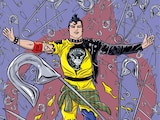DC Comics fans will recognize the name of tonight’s episode of The Flash—“Shade.” When I think of Shade, I always think of James Robinson and Tony Harris’ amazing STARMAN series—read it! —but, Shade is actually a long-time Flash villain.
Unlike many characters in the DC Comics pantheon, there has only ever been one Shade—Richard Swift. For the purpose of this article, we are going to examine his power sets and origin. What makes Shade, Shade?
The origin of the name “Shade” has even deeper literary roots than comic book history. It is derived from Dante’s famous epic poem The Divine Comedy (how is that for some recommended reading?). Within this context, “Shade” refers to the perpetual darkness found in Hell. Darker than dark. Blacker than black. Many literary scholars also believe that this use of the word “Shade” is where the phrase “a shade of vampires” (indicating a gathering), comes from.

Richard Swift was the first character to call himself Shade published by National Comics before they became known far and wide as DC Comics. He debuted in FLASH COMICS #33 published in September of 1942. It’s important to know that this was the era of the original Flash, which is to say, Jay Garrick, rather than Barry Allen.
If this is indicative of any possibility that John Wesley Shipp may be returning to the role of Jay Garrick in order to fight a monster made of shadows, then I am absolutely excited about that!
That being said, much like the events of tonight’s episode, the eponymous villain did go on to do battle with the first Flash in the red cowl, Mr. Barry Allen himself. As with many of the Golden Age and Silver Age Flash Comics rogues, Richard Swift was a run-of-the-mill thief whose antics needed to be interrupted by the Fastest Man Alive. What made him unique from many of his contemporaries was that he had the power to manipulate shadows, and they were harnessed through a magical cane. It is interesting to have Shade’s cane be both a medium to control power flow and a defensive weapon as well, as opposed to something like a magic wand that is largely passive without its magical element attached.
But, what exactly does “shadow manipulation” entail? As with various magic-based abilities across comic books, that’s often hard to nail down. From what Richard Swift has done in various comics, I can let you know that, among other things, it means control over darkness and light, travel over great distances in short amounts of time, creation of constructs out of shadows (think Green Lantern), immortality and slowed or non-aging.

As you can see directly above, Shade appears during the famous “Flash of Two Worlds” storyline (THE FLASH #123, September 1961), that fans of The Flash TV show saw brought to life on screen in season two when we thought we were being introduced to Jay Garrick. In addition to being a part of one of the most famous Flash storylines of all time, Shade has been a member of one of the most well-known super-villainous organizations in the DC Universe: The Injustice Society.
Richard Swift survived the CRISIS ON INFINITE EARTHS event intact and did not undergo a significant retcon until the event known as ZERO HOUR in 1994. His origin then became that of an English gentleman who in 1838 was part of a mysterious mystical tragedy that killed 104 people and wiped his own memory clean, leaving Swift suffering from amnesia. His shadow powers made themselves known following this same accident and eventually led him across the ocean to the United States of America where the most famous characters in the DC Universe reside.
Fun fact: There is even an adventure set during the 1960s that he shares with another famous magical DC character, Doctor Fate.

The aforementioned Starman series probably delved the deepest into Shade’s past with stories of his previous adventures told in journal entries. These entries have now been collected separately from the Starman series proper if you want to hunt them down yourself. Over the course of Starman, readers watched as Shade went from presumed antagonist to uneasy ally, undertaking one of the most startling character arcs in the entire series.
But if you’re keeping up with Rebirth, you know that Shade has again returned to the world of the Flash, and has once more taken up his villainous ways. He’s debuted last week in the new Flash storyline, “The Speed of Darkness,” which kicked off with THE FLASH #10.
But I want to go back to Starman because, even though Shade was conceived as a Flash villain, he has rarely been better portrayed than in that series and I want to remind viewers that Stargirl (a character who appears in that same series), recently appeared on DC’s Legends of Tomorrow. There may now be a reason for her to appear on The Flash if their version of Shade gets any more out of hand!
Ashley V. Robinson covers The Flash as a part of the #DCTV Couch Club. You can find her on Twitter at @AshleyVRobinson and on the Jawiin YouTube channel. The Flash airs Tuesdays at 8 p.m. (7 p.m. CST) on The CW.















